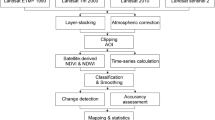Abstract
In the last two decades, tourism has led to a drastic conversion of the wetlands into settlement areas in the surroundings of Fethiye town located in the Mediterranean region of Turkey. The coast of Fethiye Bay abounds in coastal wetlands, riparian corridors, marshes, forested wetlands, swamps and grasslands that need urgent conservation. In addition to tourism activities, pollution resulting from residential and agricultural areas, urbanization, and other activities are threatening the wetland ecosystems in the area. The transformation of wetlands has resulted in a loss of biodiversity. The wildlife, notably many water birds are under a threat of extinction. These biotopes need to be monitored at short time intervals, as changes in the wetlands are rapid and serious due to these factors. Accurate and timely information will play a vital role in supporting decision making and effective sustainable management of these wetlands. In this connection the ground based survey for monitoring purpose is not entirely well-suited because of transportation difficulties as well as the working conditions. On the other hand, satellite data can provide an effective tool for mapping and monitoring of these areas. While high resolution satellite imageries including Ikonos and Quickbird generally provide detailed vegetation mapping, medium resolution satellite imageries including Landsat and Spot have been widely used for detecting the changes during definite time intervals. The aim of this study is to detect the changes in the wetlands between 1990–2001 along the coast of Fethiye and its inland parts by means of multitemporal Landsat data.
Access this chapter
Tax calculation will be finalised at checkout
Purchases are for personal use only
Similar content being viewed by others
References
Sarkar SK (2004) Sustainable management of wetlands: Biodiversity and beyond. In: Sage Publications India Pvt. Ltd. (ed) Jyoti Parikh and Hemant Datye, New Delhi, India, pp 290–291
Cowardin LMV, Carter FC, Golet ET (1979) Classification of wetlands and deepwater habitats of the United States. U.S. Department of the Interior, Fish and Wildlife Service, Washington, DC, 131 pp
Fuller RM, Groom BB, Mugisha S, Ipulet P, Pomeroy D, Katende A, Bailey R, Ogutu-Ohwayo R (1998) The integration of field survey and remote sensing for biodiversity assessment: A case study in the tropical forests and wetlands of Sango Bay, Uganda. Biol Conserv 86:379–391
Chopra R, Verma VK, Sharma PK (2001) Mapping, monitoring and conservation of Harike wetland ecosystem, Punjab, India, through remote sensing. Int J Remote Sens 22:89–98
Harvey KR, Hill GJE (2001) Vegetation mapping of a tropical freshwater swamp in the Northern Territory, Australia: A comparison of aerial photography, Landsat TM and SPOT satellite imagery. Int J Remote Sens 22:2911–2925
Wang L, Sousa WP, Gong P (2004) Integration of object-based and pixel-based classification for mapping mangroves with IKONOS imagery. Int J Remote Sens 25:5655–5668
Nayak S, Pamdeya A, Gupta MC, Trivedi CR, Prasad KN, Kadri SA (1989) Application of satellite data for monitoring degradation of tidal wetlands of the Gulf of Kachchh, Western India, Acta Astronaut 20:171–178
Bock M (2003) Remote sensing and GIS-based techniques for the classification and monitoring of biotopes, Case examples for a wet grass- and moor land area in Northern Germany. J Nat Conserv 11:145–155
Jensen RJ (1996) Introductory digital image processing: A remote sensing perspective. Prentice Hall, Upper Saddle River, NJ, 318 pp
Lu D, Mausel P, Brondizio E, Moran E (2004) Change detection techniques. Int J Remote Sens 25(12):2365–2407
Author information
Authors and Affiliations
Corresponding author
Editor information
Editors and Affiliations
Rights and permissions
Copyright information
© 2010 Springer-Verlag Berlin Heidelberg
About this chapter
Cite this chapter
Ozdemir, İ., Ozkan, K., Mert, A., Gülsoy, S. (2010). Monitoring of Wetlands by Using Multitemporal Landsat Data; A Case Study from Fethiye – Turkey. In: Gökçekus, H., Türker, U., LaMoreaux, J. (eds) Survival and Sustainability. Environmental Earth Sciences. Springer, Berlin, Heidelberg. https://doi.org/10.1007/978-3-540-95991-5_73
Download citation
DOI: https://doi.org/10.1007/978-3-540-95991-5_73
Published:
Publisher Name: Springer, Berlin, Heidelberg
Print ISBN: 978-3-540-95990-8
Online ISBN: 978-3-540-95991-5
eBook Packages: Earth and Environmental ScienceEarth and Environmental Science (R0)




